PUBH6000: Report on Social Determinants and Heart Disease Impact
VerifiedAdded on 2022/11/29
|7
|1074
|89
Report
AI Summary
This report, prepared for the PUBH6000 course, examines the impact of social determinants of health on heart disease, particularly within lower socioeconomic populations. It highlights the increased prevalence of behavioral risk factors such as poor diet, lack of physical activity, and smoking, and explores the burden of cardiovascular disease (CVD), including coronary heart disease, stroke, and heart failure. The report delves into the influence of factors like unemployment, education, social support, and access to healthcare on heart disease outcomes. It proposes public health interventions, emphasizing quality education, healthy diet promotion, and improved access to care, and suggests involving sectors beyond healthcare, such as education, to raise awareness. The conclusion underscores the need for interventions to reduce mortality and improve the quality of life for those affected by heart disease, focusing on epidemiological aspects such as incidence, morbidity, prevalence, and mortality, as well as the role of social determinants in identifying the burden of heart disease.

Running Head: Disease 0
PUBH6000
PUBH6000
Paraphrase This Document
Need a fresh take? Get an instant paraphrase of this document with our AI Paraphraser
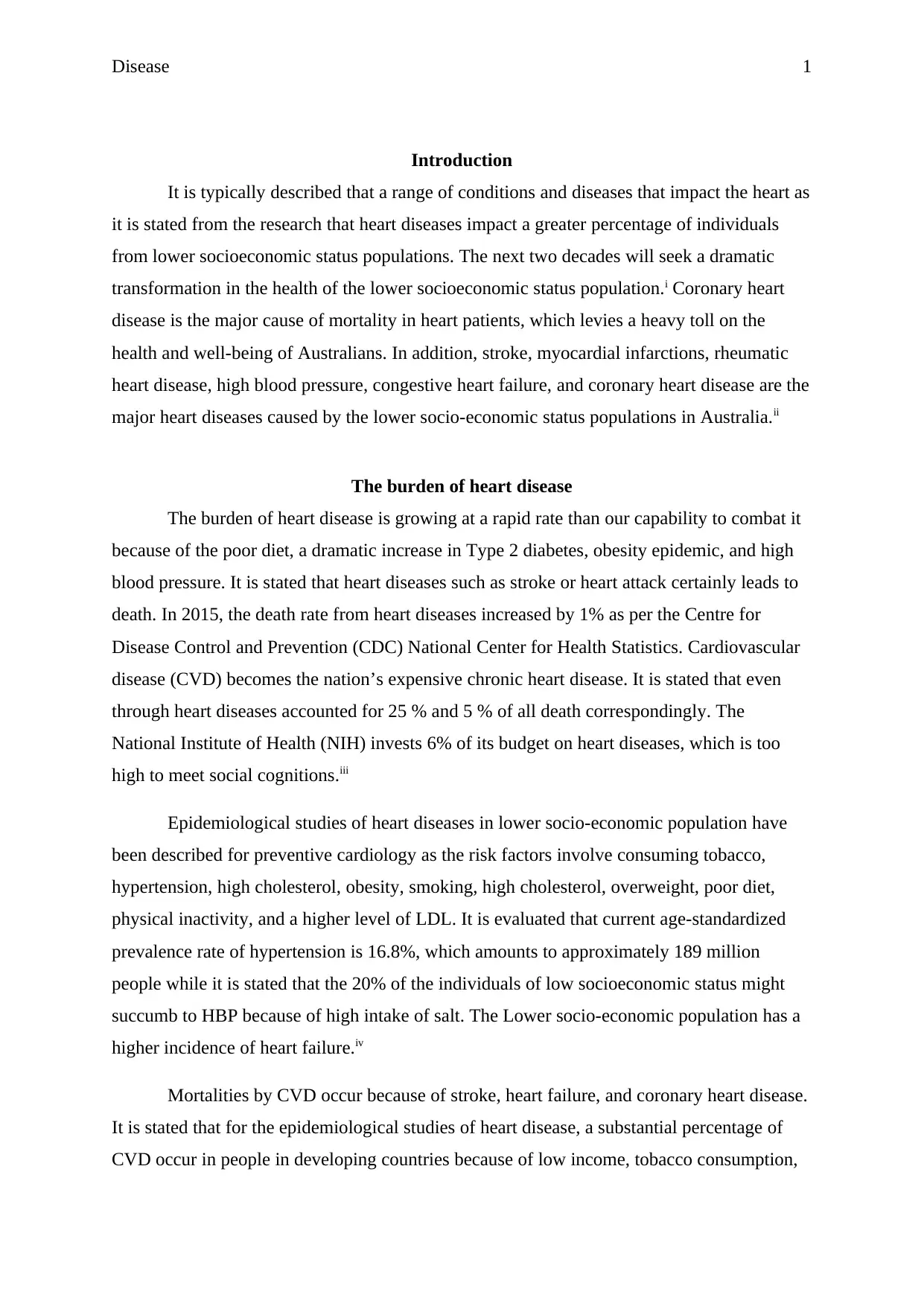
Disease 1
Introduction
It is typically described that a range of conditions and diseases that impact the heart as
it is stated from the research that heart diseases impact a greater percentage of individuals
from lower socioeconomic status populations. The next two decades will seek a dramatic
transformation in the health of the lower socioeconomic status population.i Coronary heart
disease is the major cause of mortality in heart patients, which levies a heavy toll on the
health and well-being of Australians. In addition, stroke, myocardial infarctions, rheumatic
heart disease, high blood pressure, congestive heart failure, and coronary heart disease are the
major heart diseases caused by the lower socio-economic status populations in Australia.ii
The burden of heart disease
The burden of heart disease is growing at a rapid rate than our capability to combat it
because of the poor diet, a dramatic increase in Type 2 diabetes, obesity epidemic, and high
blood pressure. It is stated that heart diseases such as stroke or heart attack certainly leads to
death. In 2015, the death rate from heart diseases increased by 1% as per the Centre for
Disease Control and Prevention (CDC) National Center for Health Statistics. Cardiovascular
disease (CVD) becomes the nation’s expensive chronic heart disease. It is stated that even
through heart diseases accounted for 25 % and 5 % of all death correspondingly. The
National Institute of Health (NIH) invests 6% of its budget on heart diseases, which is too
high to meet social cognitions.iii
Epidemiological studies of heart diseases in lower socio-economic population have
been described for preventive cardiology as the risk factors involve consuming tobacco,
hypertension, high cholesterol, obesity, smoking, high cholesterol, overweight, poor diet,
physical inactivity, and a higher level of LDL. It is evaluated that current age-standardized
prevalence rate of hypertension is 16.8%, which amounts to approximately 189 million
people while it is stated that the 20% of the individuals of low socioeconomic status might
succumb to HBP because of high intake of salt. The Lower socio-economic population has a
higher incidence of heart failure.iv
Mortalities by CVD occur because of stroke, heart failure, and coronary heart disease.
It is stated that for the epidemiological studies of heart disease, a substantial percentage of
CVD occur in people in developing countries because of low income, tobacco consumption,
Introduction
It is typically described that a range of conditions and diseases that impact the heart as
it is stated from the research that heart diseases impact a greater percentage of individuals
from lower socioeconomic status populations. The next two decades will seek a dramatic
transformation in the health of the lower socioeconomic status population.i Coronary heart
disease is the major cause of mortality in heart patients, which levies a heavy toll on the
health and well-being of Australians. In addition, stroke, myocardial infarctions, rheumatic
heart disease, high blood pressure, congestive heart failure, and coronary heart disease are the
major heart diseases caused by the lower socio-economic status populations in Australia.ii
The burden of heart disease
The burden of heart disease is growing at a rapid rate than our capability to combat it
because of the poor diet, a dramatic increase in Type 2 diabetes, obesity epidemic, and high
blood pressure. It is stated that heart diseases such as stroke or heart attack certainly leads to
death. In 2015, the death rate from heart diseases increased by 1% as per the Centre for
Disease Control and Prevention (CDC) National Center for Health Statistics. Cardiovascular
disease (CVD) becomes the nation’s expensive chronic heart disease. It is stated that even
through heart diseases accounted for 25 % and 5 % of all death correspondingly. The
National Institute of Health (NIH) invests 6% of its budget on heart diseases, which is too
high to meet social cognitions.iii
Epidemiological studies of heart diseases in lower socio-economic population have
been described for preventive cardiology as the risk factors involve consuming tobacco,
hypertension, high cholesterol, obesity, smoking, high cholesterol, overweight, poor diet,
physical inactivity, and a higher level of LDL. It is evaluated that current age-standardized
prevalence rate of hypertension is 16.8%, which amounts to approximately 189 million
people while it is stated that the 20% of the individuals of low socioeconomic status might
succumb to HBP because of high intake of salt. The Lower socio-economic population has a
higher incidence of heart failure.iv
Mortalities by CVD occur because of stroke, heart failure, and coronary heart disease.
It is stated that for the epidemiological studies of heart disease, a substantial percentage of
CVD occur in people in developing countries because of low income, tobacco consumption,
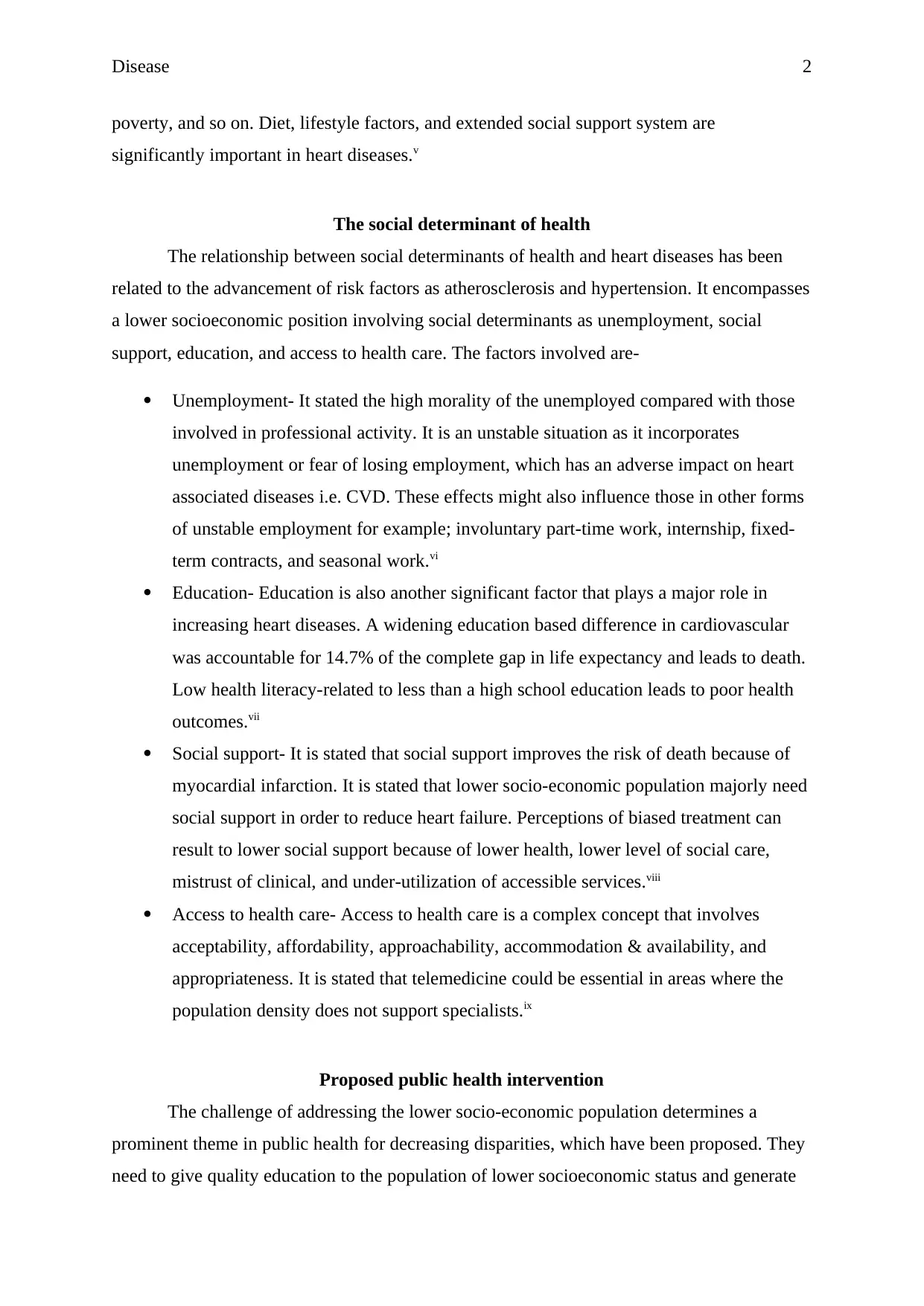
Disease 2
poverty, and so on. Diet, lifestyle factors, and extended social support system are
significantly important in heart diseases.v
The social determinant of health
The relationship between social determinants of health and heart diseases has been
related to the advancement of risk factors as atherosclerosis and hypertension. It encompasses
a lower socioeconomic position involving social determinants as unemployment, social
support, education, and access to health care. The factors involved are-
Unemployment- It stated the high morality of the unemployed compared with those
involved in professional activity. It is an unstable situation as it incorporates
unemployment or fear of losing employment, which has an adverse impact on heart
associated diseases i.e. CVD. These effects might also influence those in other forms
of unstable employment for example; involuntary part-time work, internship, fixed-
term contracts, and seasonal work.vi
Education- Education is also another significant factor that plays a major role in
increasing heart diseases. A widening education based difference in cardiovascular
was accountable for 14.7% of the complete gap in life expectancy and leads to death.
Low health literacy-related to less than a high school education leads to poor health
outcomes.vii
Social support- It is stated that social support improves the risk of death because of
myocardial infarction. It is stated that lower socio-economic population majorly need
social support in order to reduce heart failure. Perceptions of biased treatment can
result to lower social support because of lower health, lower level of social care,
mistrust of clinical, and under-utilization of accessible services.viii
Access to health care- Access to health care is a complex concept that involves
acceptability, affordability, approachability, accommodation & availability, and
appropriateness. It is stated that telemedicine could be essential in areas where the
population density does not support specialists.ix
Proposed public health intervention
The challenge of addressing the lower socio-economic population determines a
prominent theme in public health for decreasing disparities, which have been proposed. They
need to give quality education to the population of lower socioeconomic status and generate
poverty, and so on. Diet, lifestyle factors, and extended social support system are
significantly important in heart diseases.v
The social determinant of health
The relationship between social determinants of health and heart diseases has been
related to the advancement of risk factors as atherosclerosis and hypertension. It encompasses
a lower socioeconomic position involving social determinants as unemployment, social
support, education, and access to health care. The factors involved are-
Unemployment- It stated the high morality of the unemployed compared with those
involved in professional activity. It is an unstable situation as it incorporates
unemployment or fear of losing employment, which has an adverse impact on heart
associated diseases i.e. CVD. These effects might also influence those in other forms
of unstable employment for example; involuntary part-time work, internship, fixed-
term contracts, and seasonal work.vi
Education- Education is also another significant factor that plays a major role in
increasing heart diseases. A widening education based difference in cardiovascular
was accountable for 14.7% of the complete gap in life expectancy and leads to death.
Low health literacy-related to less than a high school education leads to poor health
outcomes.vii
Social support- It is stated that social support improves the risk of death because of
myocardial infarction. It is stated that lower socio-economic population majorly need
social support in order to reduce heart failure. Perceptions of biased treatment can
result to lower social support because of lower health, lower level of social care,
mistrust of clinical, and under-utilization of accessible services.viii
Access to health care- Access to health care is a complex concept that involves
acceptability, affordability, approachability, accommodation & availability, and
appropriateness. It is stated that telemedicine could be essential in areas where the
population density does not support specialists.ix
Proposed public health intervention
The challenge of addressing the lower socio-economic population determines a
prominent theme in public health for decreasing disparities, which have been proposed. They
need to give quality education to the population of lower socioeconomic status and generate
⊘ This is a preview!⊘
Do you want full access?
Subscribe today to unlock all pages.

Trusted by 1+ million students worldwide
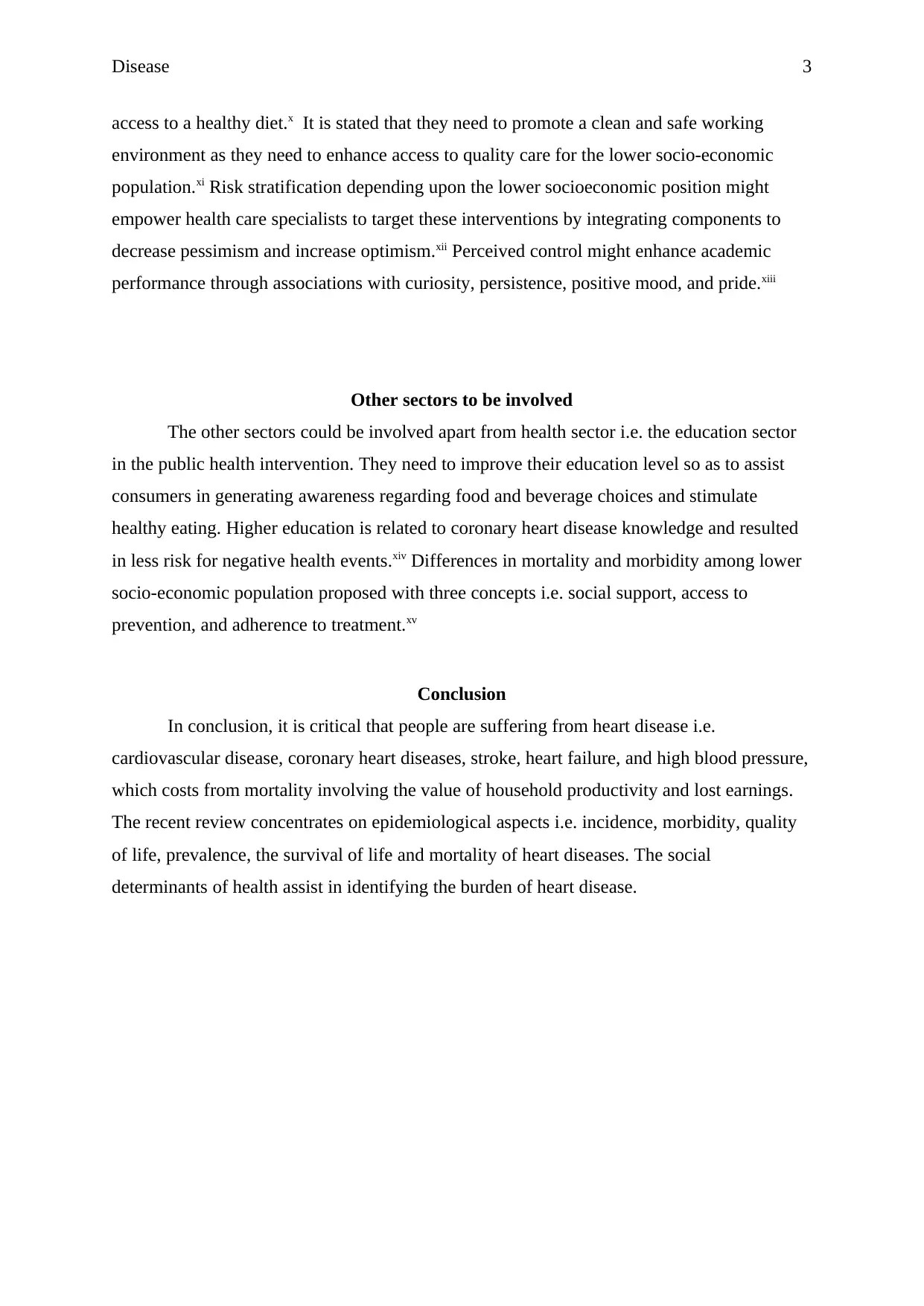
Disease 3
access to a healthy diet.x It is stated that they need to promote a clean and safe working
environment as they need to enhance access to quality care for the lower socio-economic
population.xi Risk stratification depending upon the lower socioeconomic position might
empower health care specialists to target these interventions by integrating components to
decrease pessimism and increase optimism.xii Perceived control might enhance academic
performance through associations with curiosity, persistence, positive mood, and pride.xiii
Other sectors to be involved
The other sectors could be involved apart from health sector i.e. the education sector
in the public health intervention. They need to improve their education level so as to assist
consumers in generating awareness regarding food and beverage choices and stimulate
healthy eating. Higher education is related to coronary heart disease knowledge and resulted
in less risk for negative health events.xiv Differences in mortality and morbidity among lower
socio-economic population proposed with three concepts i.e. social support, access to
prevention, and adherence to treatment.xv
Conclusion
In conclusion, it is critical that people are suffering from heart disease i.e.
cardiovascular disease, coronary heart diseases, stroke, heart failure, and high blood pressure,
which costs from mortality involving the value of household productivity and lost earnings.
The recent review concentrates on epidemiological aspects i.e. incidence, morbidity, quality
of life, prevalence, the survival of life and mortality of heart diseases. The social
determinants of health assist in identifying the burden of heart disease.
access to a healthy diet.x It is stated that they need to promote a clean and safe working
environment as they need to enhance access to quality care for the lower socio-economic
population.xi Risk stratification depending upon the lower socioeconomic position might
empower health care specialists to target these interventions by integrating components to
decrease pessimism and increase optimism.xii Perceived control might enhance academic
performance through associations with curiosity, persistence, positive mood, and pride.xiii
Other sectors to be involved
The other sectors could be involved apart from health sector i.e. the education sector
in the public health intervention. They need to improve their education level so as to assist
consumers in generating awareness regarding food and beverage choices and stimulate
healthy eating. Higher education is related to coronary heart disease knowledge and resulted
in less risk for negative health events.xiv Differences in mortality and morbidity among lower
socio-economic population proposed with three concepts i.e. social support, access to
prevention, and adherence to treatment.xv
Conclusion
In conclusion, it is critical that people are suffering from heart disease i.e.
cardiovascular disease, coronary heart diseases, stroke, heart failure, and high blood pressure,
which costs from mortality involving the value of household productivity and lost earnings.
The recent review concentrates on epidemiological aspects i.e. incidence, morbidity, quality
of life, prevalence, the survival of life and mortality of heart diseases. The social
determinants of health assist in identifying the burden of heart disease.
Paraphrase This Document
Need a fresh take? Get an instant paraphrase of this document with our AI Paraphraser

Disease 4
References
References
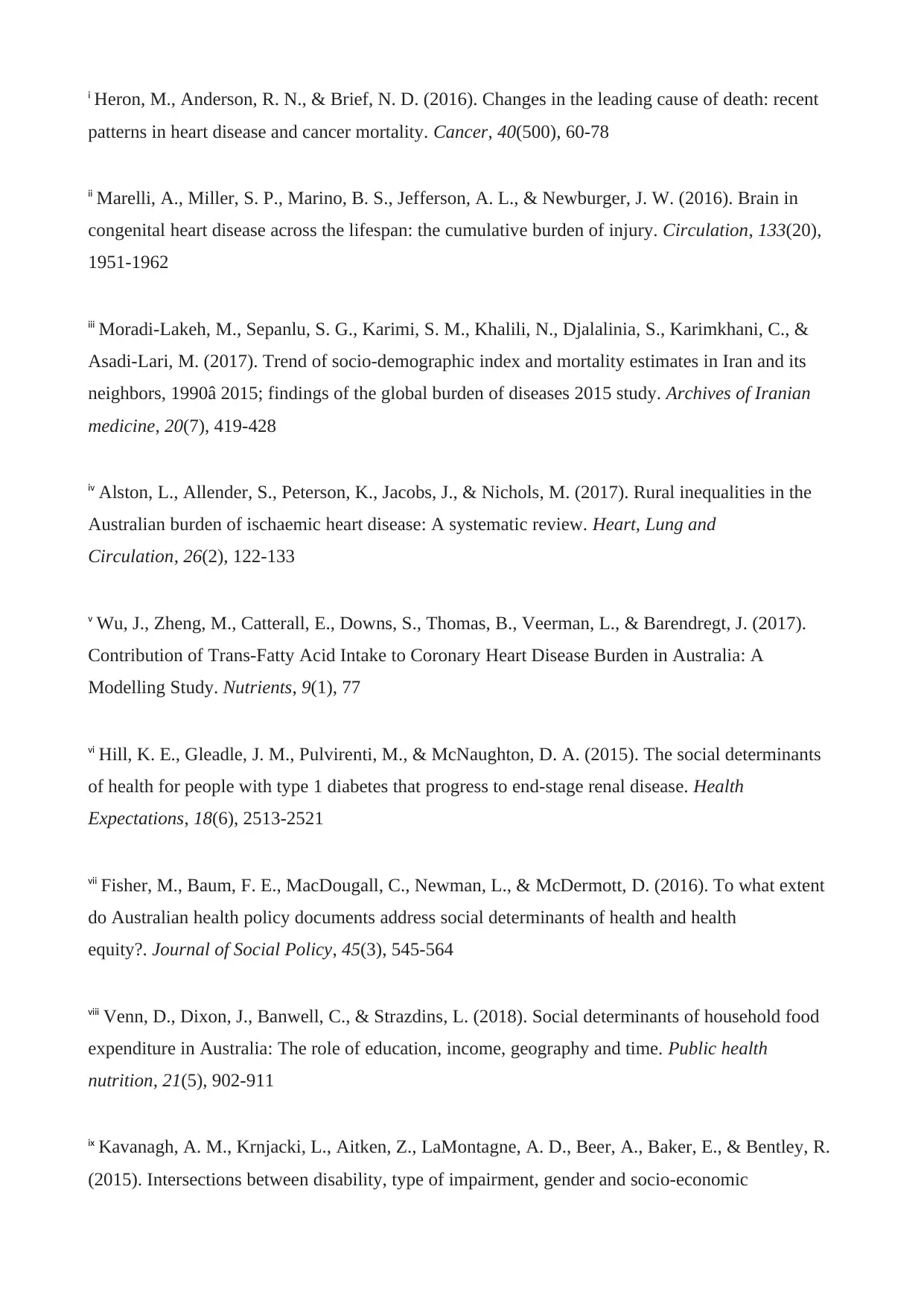
i Heron, M., Anderson, R. N., & Brief, N. D. (2016). Changes in the leading cause of death: recent
patterns in heart disease and cancer mortality. Cancer, 40(500), 60-78
ii Marelli, A., Miller, S. P., Marino, B. S., Jefferson, A. L., & Newburger, J. W. (2016). Brain in
congenital heart disease across the lifespan: the cumulative burden of injury. Circulation, 133(20),
1951-1962
iii Moradi-Lakeh, M., Sepanlu, S. G., Karimi, S. M., Khalili, N., Djalalinia, S., Karimkhani, C., &
Asadi-Lari, M. (2017). Trend of socio-demographic index and mortality estimates in Iran and its
neighbors, 1990â 2015; findings of the global burden of diseases 2015 study. Archives of Iranian
medicine, 20(7), 419-428
iv Alston, L., Allender, S., Peterson, K., Jacobs, J., & Nichols, M. (2017). Rural inequalities in the
Australian burden of ischaemic heart disease: A systematic review. Heart, Lung and
Circulation, 26(2), 122-133
v Wu, J., Zheng, M., Catterall, E., Downs, S., Thomas, B., Veerman, L., & Barendregt, J. (2017).
Contribution of Trans-Fatty Acid Intake to Coronary Heart Disease Burden in Australia: A
Modelling Study. Nutrients, 9(1), 77
vi Hill, K. E., Gleadle, J. M., Pulvirenti, M., & McNaughton, D. A. (2015). The social determinants
of health for people with type 1 diabetes that progress to end‐stage renal disease. Health
Expectations, 18(6), 2513-2521
vii Fisher, M., Baum, F. E., MacDougall, C., Newman, L., & McDermott, D. (2016). To what extent
do Australian health policy documents address social determinants of health and health
equity?. Journal of Social Policy, 45(3), 545-564
viii Venn, D., Dixon, J., Banwell, C., & Strazdins, L. (2018). Social determinants of household food
expenditure in Australia: The role of education, income, geography and time. Public health
nutrition, 21(5), 902-911
ix Kavanagh, A. M., Krnjacki, L., Aitken, Z., LaMontagne, A. D., Beer, A., Baker, E., & Bentley, R.
(2015). Intersections between disability, type of impairment, gender and socio-economic
patterns in heart disease and cancer mortality. Cancer, 40(500), 60-78
ii Marelli, A., Miller, S. P., Marino, B. S., Jefferson, A. L., & Newburger, J. W. (2016). Brain in
congenital heart disease across the lifespan: the cumulative burden of injury. Circulation, 133(20),
1951-1962
iii Moradi-Lakeh, M., Sepanlu, S. G., Karimi, S. M., Khalili, N., Djalalinia, S., Karimkhani, C., &
Asadi-Lari, M. (2017). Trend of socio-demographic index and mortality estimates in Iran and its
neighbors, 1990â 2015; findings of the global burden of diseases 2015 study. Archives of Iranian
medicine, 20(7), 419-428
iv Alston, L., Allender, S., Peterson, K., Jacobs, J., & Nichols, M. (2017). Rural inequalities in the
Australian burden of ischaemic heart disease: A systematic review. Heart, Lung and
Circulation, 26(2), 122-133
v Wu, J., Zheng, M., Catterall, E., Downs, S., Thomas, B., Veerman, L., & Barendregt, J. (2017).
Contribution of Trans-Fatty Acid Intake to Coronary Heart Disease Burden in Australia: A
Modelling Study. Nutrients, 9(1), 77
vi Hill, K. E., Gleadle, J. M., Pulvirenti, M., & McNaughton, D. A. (2015). The social determinants
of health for people with type 1 diabetes that progress to end‐stage renal disease. Health
Expectations, 18(6), 2513-2521
vii Fisher, M., Baum, F. E., MacDougall, C., Newman, L., & McDermott, D. (2016). To what extent
do Australian health policy documents address social determinants of health and health
equity?. Journal of Social Policy, 45(3), 545-564
viii Venn, D., Dixon, J., Banwell, C., & Strazdins, L. (2018). Social determinants of household food
expenditure in Australia: The role of education, income, geography and time. Public health
nutrition, 21(5), 902-911
ix Kavanagh, A. M., Krnjacki, L., Aitken, Z., LaMontagne, A. D., Beer, A., Baker, E., & Bentley, R.
(2015). Intersections between disability, type of impairment, gender and socio-economic
⊘ This is a preview!⊘
Do you want full access?
Subscribe today to unlock all pages.

Trusted by 1+ million students worldwide
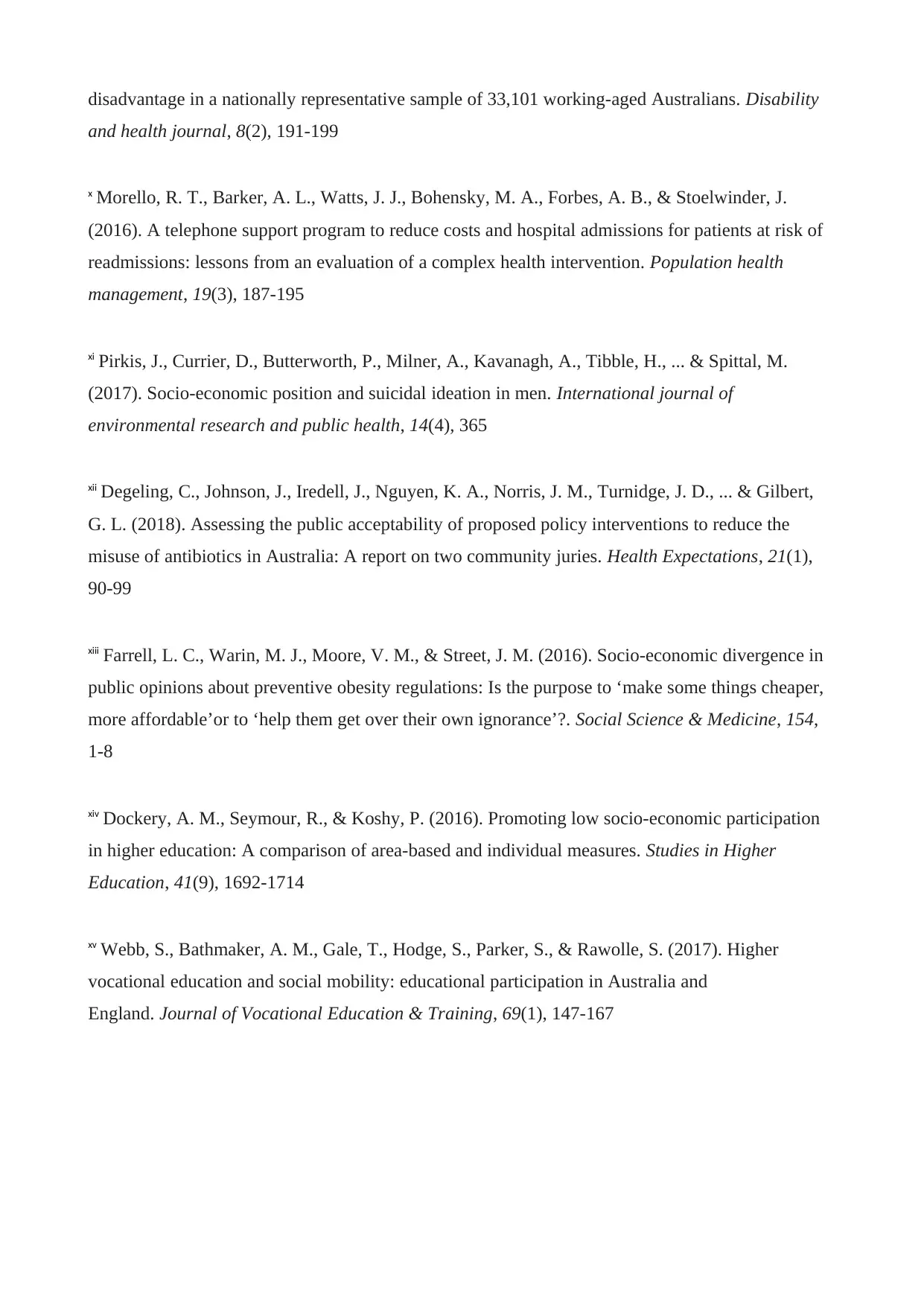
disadvantage in a nationally representative sample of 33,101 working-aged Australians. Disability
and health journal, 8(2), 191-199
x Morello, R. T., Barker, A. L., Watts, J. J., Bohensky, M. A., Forbes, A. B., & Stoelwinder, J.
(2016). A telephone support program to reduce costs and hospital admissions for patients at risk of
readmissions: lessons from an evaluation of a complex health intervention. Population health
management, 19(3), 187-195
xi Pirkis, J., Currier, D., Butterworth, P., Milner, A., Kavanagh, A., Tibble, H., ... & Spittal, M.
(2017). Socio-economic position and suicidal ideation in men. International journal of
environmental research and public health, 14(4), 365
xii Degeling, C., Johnson, J., Iredell, J., Nguyen, K. A., Norris, J. M., Turnidge, J. D., ... & Gilbert,
G. L. (2018). Assessing the public acceptability of proposed policy interventions to reduce the
misuse of antibiotics in Australia: A report on two community juries. Health Expectations, 21(1),
90-99
xiii Farrell, L. C., Warin, M. J., Moore, V. M., & Street, J. M. (2016). Socio-economic divergence in
public opinions about preventive obesity regulations: Is the purpose to ‘make some things cheaper,
more affordable’or to ‘help them get over their own ignorance’?. Social Science & Medicine, 154,
1-8
xiv Dockery, A. M., Seymour, R., & Koshy, P. (2016). Promoting low socio-economic participation
in higher education: A comparison of area-based and individual measures. Studies in Higher
Education, 41(9), 1692-1714
xv Webb, S., Bathmaker, A. M., Gale, T., Hodge, S., Parker, S., & Rawolle, S. (2017). Higher
vocational education and social mobility: educational participation in Australia and
England. Journal of Vocational Education & Training, 69(1), 147-167
and health journal, 8(2), 191-199
x Morello, R. T., Barker, A. L., Watts, J. J., Bohensky, M. A., Forbes, A. B., & Stoelwinder, J.
(2016). A telephone support program to reduce costs and hospital admissions for patients at risk of
readmissions: lessons from an evaluation of a complex health intervention. Population health
management, 19(3), 187-195
xi Pirkis, J., Currier, D., Butterworth, P., Milner, A., Kavanagh, A., Tibble, H., ... & Spittal, M.
(2017). Socio-economic position and suicidal ideation in men. International journal of
environmental research and public health, 14(4), 365
xii Degeling, C., Johnson, J., Iredell, J., Nguyen, K. A., Norris, J. M., Turnidge, J. D., ... & Gilbert,
G. L. (2018). Assessing the public acceptability of proposed policy interventions to reduce the
misuse of antibiotics in Australia: A report on two community juries. Health Expectations, 21(1),
90-99
xiii Farrell, L. C., Warin, M. J., Moore, V. M., & Street, J. M. (2016). Socio-economic divergence in
public opinions about preventive obesity regulations: Is the purpose to ‘make some things cheaper,
more affordable’or to ‘help them get over their own ignorance’?. Social Science & Medicine, 154,
1-8
xiv Dockery, A. M., Seymour, R., & Koshy, P. (2016). Promoting low socio-economic participation
in higher education: A comparison of area-based and individual measures. Studies in Higher
Education, 41(9), 1692-1714
xv Webb, S., Bathmaker, A. M., Gale, T., Hodge, S., Parker, S., & Rawolle, S. (2017). Higher
vocational education and social mobility: educational participation in Australia and
England. Journal of Vocational Education & Training, 69(1), 147-167
1 out of 7
Related Documents
Your All-in-One AI-Powered Toolkit for Academic Success.
+13062052269
info@desklib.com
Available 24*7 on WhatsApp / Email
![[object Object]](/_next/static/media/star-bottom.7253800d.svg)
Unlock your academic potential
Copyright © 2020–2025 A2Z Services. All Rights Reserved. Developed and managed by ZUCOL.





